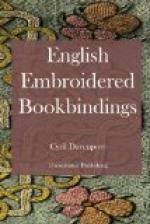A copy of the Bible, printed in London in 1626, is bound in canvas, and measures 6 by 3-1/2 inches.
The embroidery is in coloured silks, silver cords and threads, and silver guimp. On the upper cover is a small full-length figure of St. Peter, with short beard, holding a key in his left hand. He is dressed in a blue under-garment, with red and orange robe over it, all the edges being marked by a silver twist, some of which has come off. The ground is green and in hillocks. All this work is done in coloured silks and silver threads in shading stitch.
On the under side is a figure of St. Paul, with long beard, holding a silver sword in his right hand. He wears a blue under-garment, with red and orange upper robe, all edged with silver twist. The feet of both figures are bare. The rest of the design is the same on both sides. The skies are worked in large stitches of blue and yellow silk and silver threads, graduating from dark to light; above these are canopies of silver thread, couched, and vandyked at the edge. Enclosing the figures are arches with columns, in high relief in silver cords and threads. The inner edge of the arch is curiously marked by a line of brown silk worked over a strip of vellum in the manner used for hand-worked head-bands, and the outer edge has ‘crockets’ of silver guimp. The columns rest upon ‘rams-horn’ curves, heavily worked in relief with silver threads, the insides of the curves worked in brown silk over vellum like the inner edge of the arch.
Metal Threads used on Embroidered Books.
Guimp and gold threads are largely used, as has already been noticed, in embroidered books from early times, but on the next specimen of a canvas-bound book I have chosen for description, dated 1642, a kind of metal thread occurs which is very curious. It is used at an earlier date on satin books, and it is also found more commonly upon them; but as I have put the canvas books first for the purpose of description, and the ‘thread’ occurs in one of them, this is the best place to put its description. This thread I call ‘Purl,’ and a thread with this name is mentioned in several places as having been used in England in the seventeenth century; but there is no description of it, so that this thread may not be the ‘purl’ mentioned by the seventeenth-century writers, but if it is not, I do not know what purl is, neither do I know any other special name for the thread. In order that there may be no doubt as to what I mean by purl, I will shortly describe the thread as I know it.
First there is a very fine copper wire; this is closely bound round with coloured silk, also very fine, and in this state it looks simply like a coloured thread. Then this coloured thread is itself closely coiled round something like a fine knitting-needle—in fact I have made it on one—and then pushed off in the form of a fine coiled tube. The thread is always cut into short lengths for use, and on books




